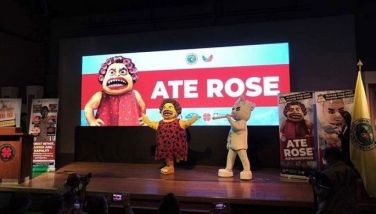A little half-brewed
Film review: Harry Potter and the Half-Blood Prince
MANILA, Philippines - Adapting a novel into film is a test in narrative economy. The challenge for the director is to compress several hundred pages of words into two hours or so of images and sound without compromising the narrative trajectory. In the case of a series-in-progress, the task is even more complicated, as the director must not violate what his or her predecessors have established. In Harry Potter and the Half-Blood Prince, the onus is on David Yates, and he bears it somewhat shakily.
The sixth installment of the Harry Potter series, Half-Blood Prince has the eponymous hero returning to battle the Death Eaters, who, since the resurgence of their leader Voldemort, have been wreaking havoc on the worlds of wizards and “muggles” (non-magical people) both. Harry must retrieve an important memory from a professor, because it possibly holds the key to defeating the Dark Lord. Meanwhile, Draco Malfoy, Harry’s adversary since the first installment, is given a mission by Voldemort to kill Dumbledore, headmaster of Hogwart’s School and Harry’s protector. Before the final confrontation occurs, however, Harry and his friends, now in their late teens, get themselves romantically entangled.
The bare-bones summary does not begin to suggest the bulk (652 pages thick) of J. K. Rowling’s novel, with its numerous subplots and references to previous books in the series. Yates has had to omit, substitute, transpose, and condense episodes — no mean task, especially for one who risks displeasing his primary examiners, the several million devotees of the Potter books (400 million copies sold to date). The pressure must have been great, and as in almost all exam situations, there are pluses and minuses.
Yates succeeds for the most part in condensing the first several chapters of the book in a few minutes of screen time. (Of course, he has the benefit of the previous movies doing the exposition for him.) In some instances, he even improves on Rowling, avoiding the more implausible devices she resorts to, to create or resolve plot difficulties.
 He arranges elements in a scene with the eye of a still-life painter, juxtaposing images to good effect. In an early scene, for example, Harry and his friends Hermione and Ron have a laugh. The laughter echoes as the camera slowly closes up on a picture of an unsmiling Draco printed on a page of the Daily Prophet, its edges on fire.
He arranges elements in a scene with the eye of a still-life painter, juxtaposing images to good effect. In an early scene, for example, Harry and his friends Hermione and Ron have a laugh. The laughter echoes as the camera slowly closes up on a picture of an unsmiling Draco printed on a page of the Daily Prophet, its edges on fire.
The difficulty is in the putting of these little set pieces in order. Early in the movie, for example, Yates introduces viewers, unobtrusively but effectively, to the werewolf Fenrir; but as the movie progresses the significance of his character is lost. In the book, the werewolf bites one of Ron’s brothers, an incident which allows his bride-to-be an opportunity to declare her love despite everything and for the book to reiterate its theme. The existence of that brother, however, is not even indicated in the movie. One begins to think that Yates felt compelled to put in scenes and characters simply because devoted readers might be doing an attendance check. But since he has narrowed down the material considerably, a number of things that he puts in leaves viewers, especially those who haven’t read the book, befuddled.
Indeed, Yates seems to rely overmuch on viewers’ familiarity with the novel for him neither to explain certain things (e.g., Borgin and Burke’s, the Marauders’ Map) nor to re-introduce characters (e.g., Tonks, Aragog). Even those whose memory of the novel is fresh may find the movie springing on them a surprise or two. The romantic rigadoon of Harry and his friends, in particular, can be disorienting. It may help to remember, though, that Yates was the director of the last Harry Potter movie, and so he may take such things as the Room of Requirement (watch for the Narnia reference), introduced in the last movie and an important setting in this one, for granted.
More serious is that sometimes what Yates leaves out are arguably the more important aspects of the story, although he sticks to the book when it comes to certain pivotal scenes (e.g., the poisoned necklace). The mystery of the Half-Blood Prince is somehow lost in the melee, to be resolved only in a line of dialogue near the movie’s end. (And so the scene in which Harry gives Ron an antidote becomes implausible whereas it isn’t in the book.) The flashbacks into Voldemort’s past, what should be the main attraction of this installment, are so truncated that they are rendered almost inutile, at least in terms of character development. In the book, Voldemort’s motives are established in those flashbacks; in the movie he is just another villain (or prankster), only much more powerful.
There is one departure from the book, however, that is especially felicitous. And it is a scene that Yates invented. Harry spends the holiday with the Weasleys, but he gets an unexpected visit from the Death Eaters. They surround the Weasley home in flames, leaving a gap in the fiery ring to lure Harry out. It’s all a trap, of course, with the upshot that the Weasley house is burned down. The scene affords viewers a brief but exciting wizard battle and economically obviates the one that Rowling puts in the end of the book, which had it been filmed would have been predictable and even clunky. But the scene does more than that. When, in the last 20 minutes of the movie, Dumbledore creates a protective ring of fire around Harry and himself as they cross a lake (echoes of The Ten Commandments here) infested with Gollum-like creatures, the scene with the Weasleys is recalled as an ironic counterpoint. Fire seems to be the unifying image in the movie, as much as circles and clocks were in the third (which is arguably still the best in the series), and it serves to illuminate one of the recurring themes in the Potter series.
Overall, then, Harry Potter and the Half-Blood Prince is, like the wizard duels one finds described in the books and acted out in the movies, a case of hits and misses. The Half-Blood Prince was an expert in potions making. This one tastes a little half-brewed.
- Latest
- Trending































